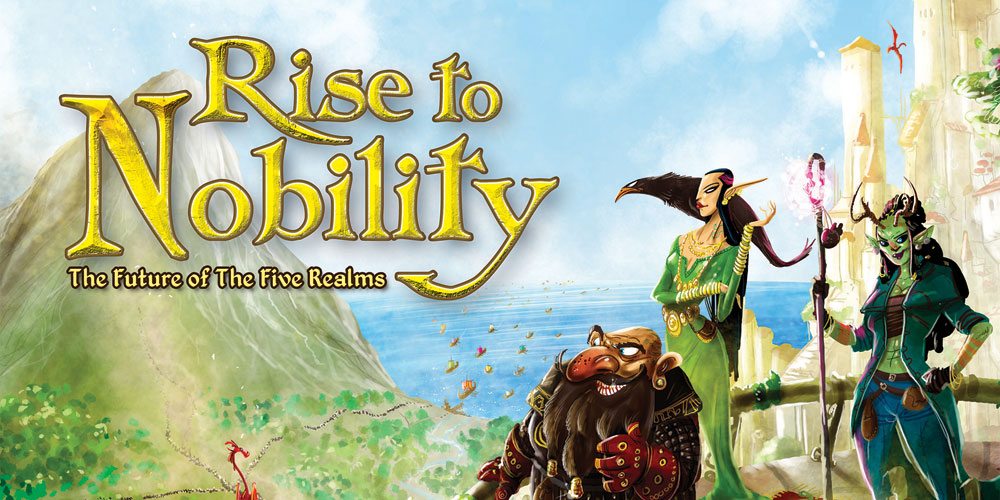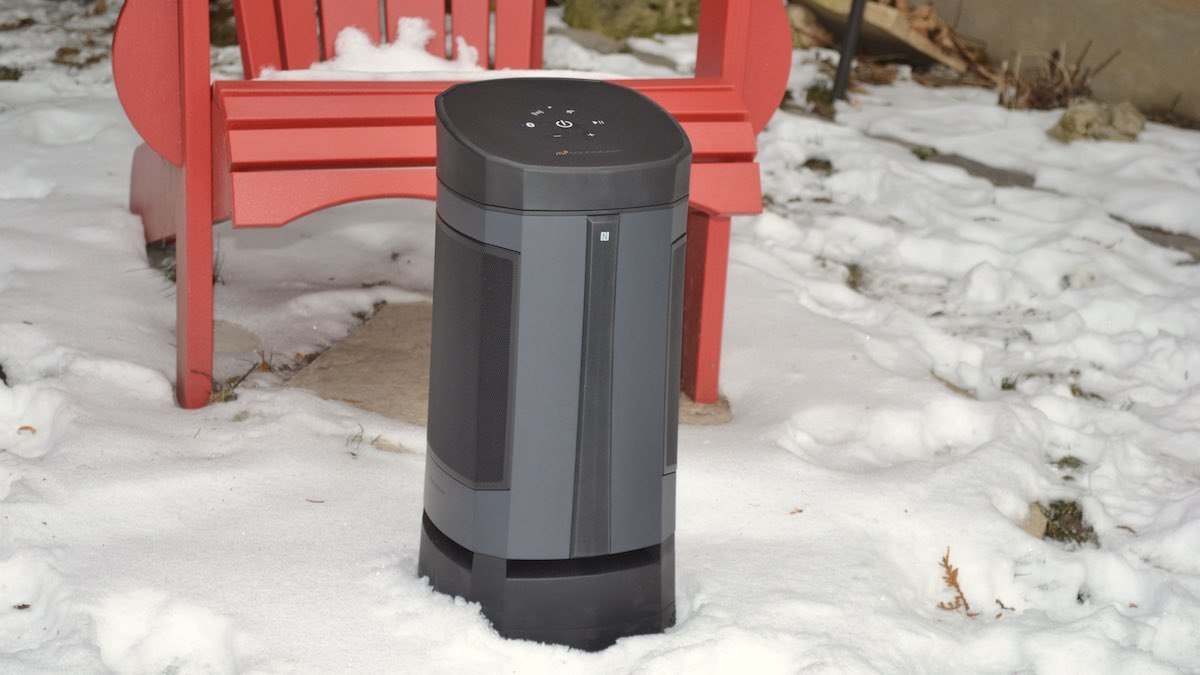Relive the exciting parts of James Cameron’s megahit Titanic, and find out if there really was room for Jack on that door, in Spin Master’s Titanic: The Game.
What Is Titanic: The Game?
Titanic: The Game is a game for 2-5 players, ages 12 and up, and takes about 40 minutes to play. It is currently available for purchase from Amazon and your friendly local game store.
Note: As an Amazon affiliate, I earn from qualifying purchases.
Titanic: The Game was designed by Daryl Andrews and Adrian Adamescu and published by Spin Master Games, with illustrations by Judit Tondora and Mat Edwards.
Titanic: The Game Components

Inside the box, you’ll find:
- 1 game board, showing the ship
- 4 top deck tiles
- 36 location tiles
- 9 lifeboats
- 1 collapsible lifeboat
- 54 passenger meeples, in 3 colors
- 40 action cubes
- 15 star tokens
- 15 life preserver tokens
- 1 door tile
- 1 Heart of the Ocean token
- 5 reference cards
- 5 character tiles
- 5 character standees
- 5 player mats
- 5 score markers
- 7 private objective cards
- 44 star cards
- 15 flood cards
- 1 funny card
- 2 flood line markers
- 1 dry erase marker
- 9 automaton tokens
The components are all of the high quality you would expect from a game published by a major company like Spin Master.

The board itself is nice and big and beautifully illustrated with the ship at the top and the iceberg on the right, as if the collision had just occurred and the ship is pulling away to its doom.
The remaining cardboard pieces (which makes up pretty much everything except the cards, meeples, and action cubes) are thinner cardboard than you see in a lot of games, but still plenty sturdy enough to hold up to repeated plays. Everything features full color and very beautiful illustrations.
In the game, players take on the role of one of the characters from the movie: Jack, Rose, Cal, Ruth (Rose’s mother, for those who haven’t seen the movie in a long time) and Captain Smith Interestingly, the character tiles, scoring tokens, and standees all feature art that is somewhat abstracted from the characters, rather than photos of the actors. I don’t think this is rights issue, as the cards feature photo stills from the movie, including shots with DiCaprio and Winslet and the other actors. Instead, it seems that it was an intentional choice by the designers to go with a more artistic look to the game, which ends up working quite nicely. These artistic renderings of the characters are on the standees, the character tiles, and the scoring tokens, and all are backed up by colors on the player boards.

The rooms of the ship are represented by a set of rectangular tiles, each showing two rooms, and a set of four tiles representing each of nine decks on the ship. Each deck’s tiles are slightly smaller than the deck above, which makes sorting and setting them up quite easy.
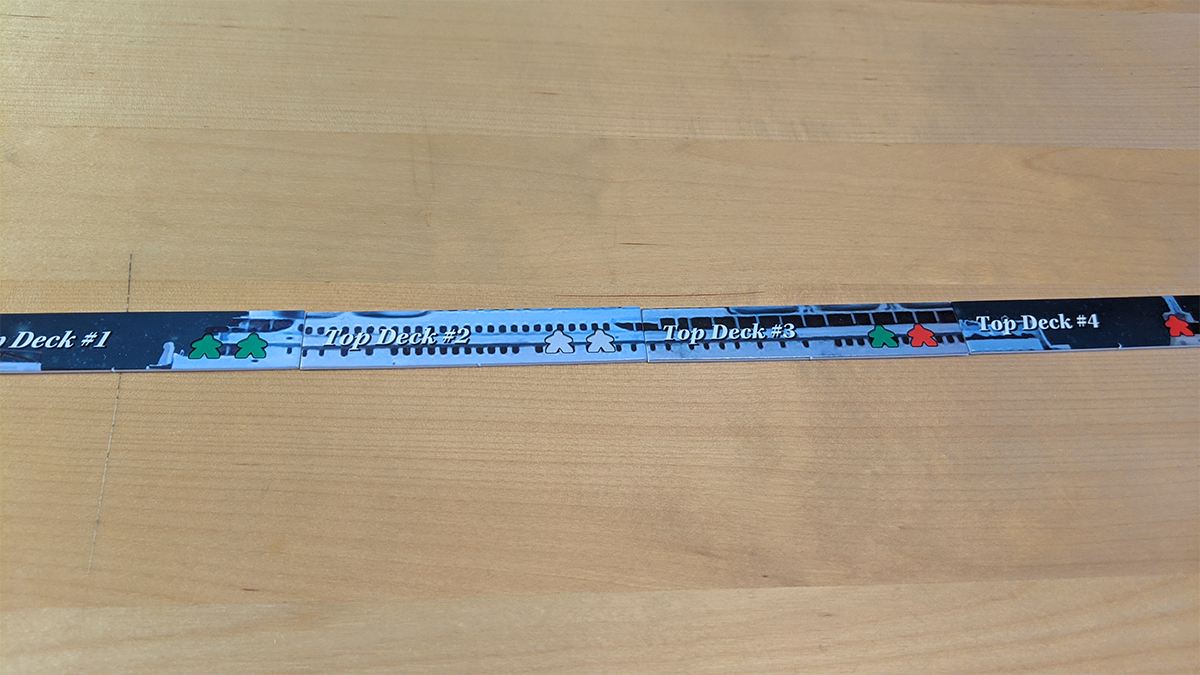
There are also four tiles representing the ship’s top deck.
The flood line markers are simply vaugely wave-shaped cardboard, which isn’t a criticism: they do the job they’re intended to do.
The liferafts are numbered for ease of setup, and show a number of passengers each can hold. There are two collapsible liferafts, one of which is used depending on player count.
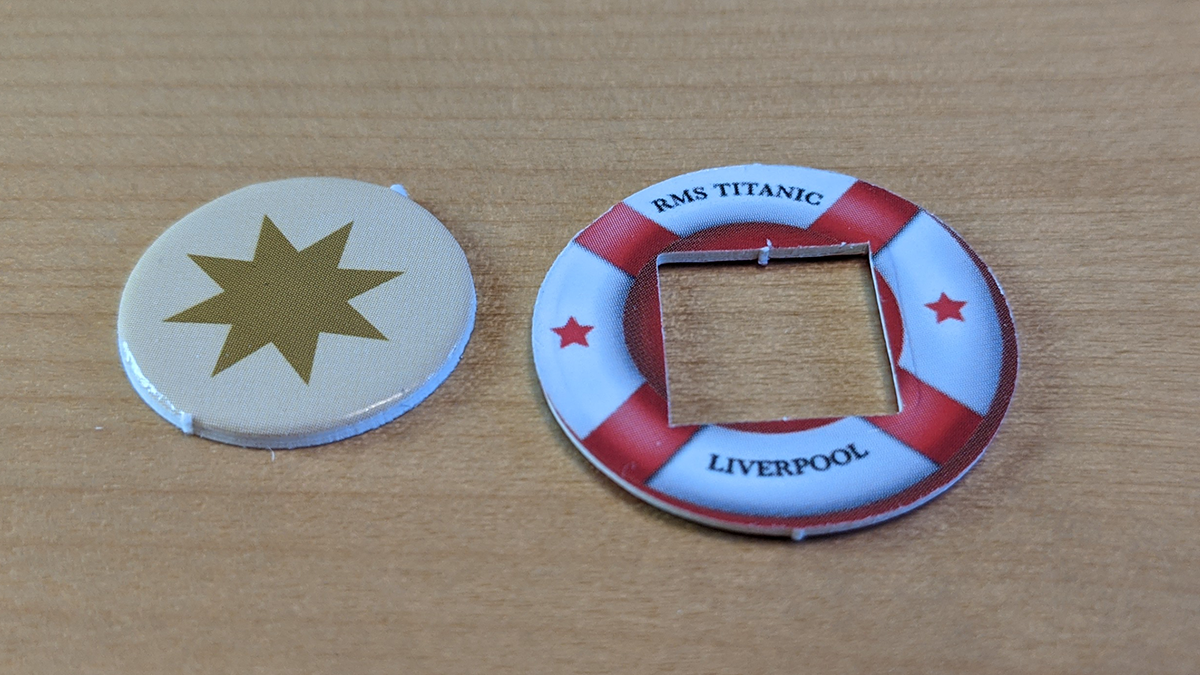
The lifesavers and star tokens are also cardboard. The lifesavers have an impressive level of detail given their size.
The Heart of the Ocean toksn is simply a representation of the movie’s famous pendant.
And then there’s the door token.

The meeples are much smaller than normal ones, which was necessary to fit a whole bunch of them onto the life rafts. They come in three somewhat arbitrary colors–red for third class passengers, grey for second class, and green for first class. However, those colors representing those different classes will get lost very quickly–as soon as we started playing, it was just a matter of “red scores more than green”. We neither remembered nor, frankly, cared why.
The action cubes are one of the better implemented components in the game. Instead of having a set number of actions you can perform each turn, you can do as many actions as you have cubes for. And while you start with three, you can pick up more, up to maximum of five. However, you can also choose to get rid of action cubes to score extra points, deciding to trade additional actions in future rounds for points in this round. The cubes themselves are small translucent blue cubes that fit nicely in the open slots on the player boards, and are supposed to be slid back and forth as you spend actions. In practice, counting to three, four, or five each round isn’t difficult, so we rarely actually moved the cubes, but the visual reminder of how many actions are available was still helpful.
The game has three decks of standard-sized plastic-backed cards, although one of those is really four decks. The first is the flood deck, which includes cards that are drawn each round that show players which part of the ship has flooded and essentially provide the timing mechanism of the game.

Players are each dealt a single card from the private objectives deck at the start of the game, which gives them additional points if they achieve a goal. Each card has five objectives, with one per character, providing for a lot of variety. However, they do create a mechanism where it turns out to be pretty easy to guess each player’s objectives by the way they play.
The final deck, or decks, are the “star cards”, which are broken into four smaller decks (item, person, location, scene) that more directly invoke elements from the movie and serve as “special power” cards for the players.
How to Play Titanic: The Game
You can download a copy of the rulebook here.
The Goal
The goal of the game is to survive the sinking ship while rescuing as many other passengers as you can.
Setup
Place the board in the middle of the table. Place the 4 top deck tiles on the spaces at the top of the ship.
Sort the location tiles by type (and size) and place them on a board, with the 900 tiles on the bottom row and then working your way up. You can either randomize them on each level or place them in letter order. Neither matters much for the game, but letter-order creates a more historically accurate map of the ship.

Place the 9 lifeboats on the spots indicated on the board, with the odd-numbered rafts on the left of the ship and the even numbered on the right, going from high to low.
Select the collapsable lifeboat that matches the number of players on the spot marked at the top of the board.
Place passenger pawns (the meeples) on each matching icon on the location tiles. Place the lifesavers, action cubes, and star tokens in piles off to the side. Separate the star cards by type, shuffle each deck, and place them separately near the board. Shuffle the 12 flood cards and then place in another deck. Place the door and the Heart of the Ocean tiles next to the board as well.

Each player chooses a character they want to play and takes the character tile, standee, mat, and score marker. The socre markers are placed on the first space on the score track, while the character tile is placed in the left slot of the player mat, ability side up.
Shuffle the private objective cards and deal one to each player, returning the rest to the box. Distribute action cubes to each player based on the player count: 4 in a 2 player game, 3 with 3 players, 2 with 4, and 1 with 5.
Place the two flood markers at the bottom of the ship.
Decide on a starting player, and then in turn order, each player places their standee on a 100-level tile and take the passenger, lifesaver, action cube, or star token as indicated by the tile they choose.
Gameplay
On each turn, players will complete three phases.
Actions Phase
In the actions phase, players can complete as many actions as they can. When using an action that requires an action cube, they slide the cube from one side of their player mat to the other.
Moving requires one cube. You can move to any adjacent room so long as the path is not blocked by walls. Each tile has two rooms on it. You can move left, right, up or down. You can also enter flooded tiles as long as they are above the flood line, but a flooded tile is considered a single room. Two or more players may occupy the same room. You can repeat this action as many times as you have remaining cubes.
Pick up is a free action that does not require spending a cube. When you enter a new room, you can pick up one item from that room. If there is a passenger in the room, you “rescue” them by taking the meeple from the tile and placing them on one of your available lifesavers. If you pick up a lifesaver, you take one from the supply and add it to your player mat; each player can have a maximum of five lifesavers. If you pick up an action cube, you take one from the supply and add it to your mat on the “used” side, so you cannot use an action cube on the turn in which you gain it. If you pick up a star token, you take one from the supply and place it near your mat. If you take a lifesaver, action cube, or star token, use the dry-erase marker to mark that item off so that you and other players know it has been taken and cannot be taken again. You cannot pick up more than one item per move action–you would need to leave and re-enter a room to get another item from the same room.
Saving passengers costs a cube. If you’re in a room that has an adjacent lifeboat, you can move any numer of passengers from your lifesavers to the liferaft. Each lifeboat has a set capacity that cannot be exceeded.
Each red passenger saved is worth 3 points, grey passengers are worth 2, and green, 1. These points are earned by the player immediately by moving their scoring token up on the scoring track. To incentivize filling up lifeboats, the last few seats on each also score points. Each lifeboat also has a space for an action cube, so players can choose to give up an action for future turns to score more points.
Playing star cards is a free action. You can play any number of cards on a turn. Cards generally provide some kind of benefit, and may score additional points at the end of the game.
Using your character’s special ability it also free, but once you use the ability, you flip your card over to its used side. To reload it and activate the ability again, you have to go all the way up to the top deck.
Flooding Phase
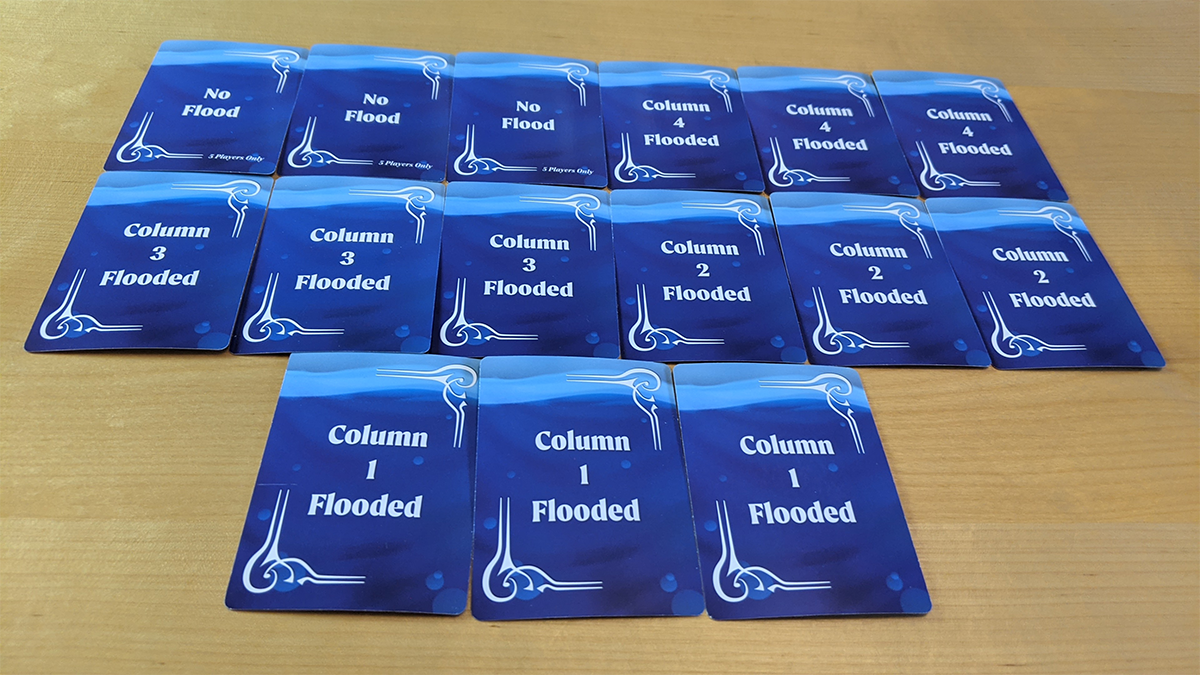
Once a player has done everything they want to, they move to the flooding phase. Here, they draw the top flood card. This will indicate the column that will flood. The player will then remove from the game the lowest room tile in that column. Any items on the tile are saved for the moment. They, the check to see if the whole row is flooded. If it is, they move the flood line tiles up to the top of that row. Any remaining components below the flood line are lost and removed from the game. Passengers lost are placed on the iceberg, as they may be relevant to end-game scoring.
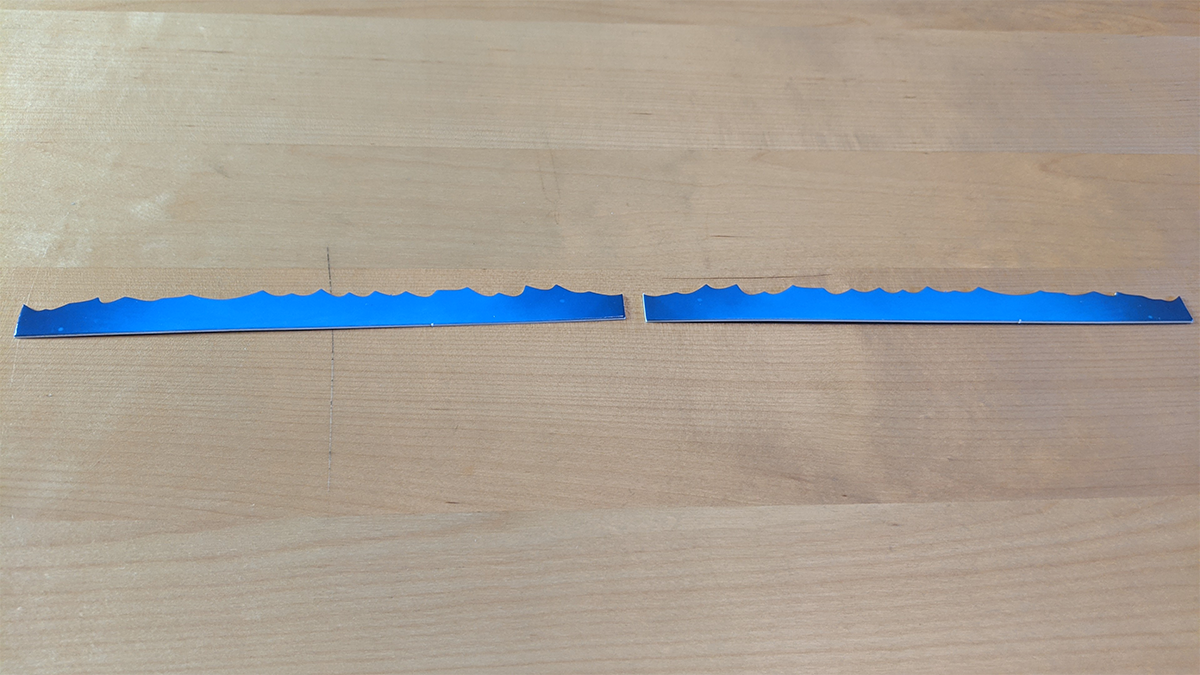
If the row is not flooded, then any passengers on the tile that was removed are placed on the flooded space. Any other unclaimed components are replaced by their physcial counterparts in the flooded room.
Finally, any players below the flood line are rescued. They will float up to the tile directly above where they were. They can choose either room on the tile. They also loose 3 points.
When the flood deck is depleted, reshuffle it.
Star Phase

The final step of each player’s turn is to spend star tokens to draw new star cards. The player may spend as many star tokens as they want, and can freely choose while deck to draw from, but every player has a hand limit of 3.
Once a player has finished their turn, play passes to the left.
The Heart of the Ocean tile is claimed as soon as a player is definitely the lowest-scoring play on the the score track. As long as they hold the necklace, they get one extra action per turn. At the end of each round, once all players have completed a turn, the Heart goes to the player with the lowest score. If there’s a tie, the Heart stays with the player who had it in the last round.
The door tile is claimed by the first person to reach 20 points. In a 3-5 player game, this player is now protected from elimination. In a two player game, this player gains an extra star card instead.
Lifeboats launch automatically either when the floodline passes its level or when it is full. No player needs to spend an action to launch the boat.
The collapsible lifeboat is the last-ditch effort by the players to get off the boat. Like other boats it is loaded back-to-front, but here the points are reversed–the first player on the boat gets the most points, the second, slightly less, and so forth. The final player on the boat gets negative points.
Once the collapsible boat launches, any player not on board is eliminated from the game, unless it’s a 3-5 player game and that player has the door.
Game End
The game ends when the flood level completely floods, launching the collapsible boat.
At that point, all players reveal their private objective cards and add those points to their totals. The winner is the player with the most points. If there’s a tie, the player with fewer action cubes wins.
Why You Should Play Titanic: The Game
In the incredibly crowded game market we live in today, an obvious way to get your game the attention it needs to stand out is to base it on an existing property, and basing a game on an Academy Award-winning film that also happens to be on the highest grossing films of all time and that still has fans some twenty three years later is an easy call.
But putting the word “Titanic” and the movie’s iconic poster on the box isn’t going to be enough, because a bad game, like a bad sequel, will get you some sales in the beginning, but that only lasts so far.
Thankfully, designers Daryl Andrews and Adrian Adamescu didn’t fall into that trap. They managed to craft a game that both invokes the spirit of the movie while still standing on its own; a game that is simple enough to be playable by fans of the movie who maybe are’t int heavy games and yet has enough depth to appeal to those on the other side of the spectrum.

The game is also not without humor, and the biggest joke in the game addresses the movie’s most enduring controversy. The character standees are really rather small, and the passenger meeples even smaller still, and yet the door token is huge. Not only could Rose easily make room for Jack, but in fact, for all of the characters. There’s even a card in the game that calls out the joke. (And in case you didn’t see it, the Mythbusters long ago proved that even in the movie version, there was always enough toom for Jack.)
There is of course the issue of making a game out of human tragedy. It’s worth remembering that the actual Titanic–the remains of the ship sitting at the bottom of the ocean–is also the final resting place of at least 1,500 people. But I’d argue that the movie glosses over much of that tragedy–the final act is as much an action-adventure shoot-em-up chase sequence as it is the telling of a tragedy–and the game is ultimately based on the movie, not the actual sinking. But that said, the theme of the movie is about the power of love, while the theme of the game is saving as many passengers as possible, so the game’s designers I think ultimately do a better job of getting their players to think about what was really happening in the middle of the Atlantic on that April night in 1912 than James Cameron did.
Click here to see all our tabletop game reviews.
![]() To subscribe to GeekDad’s tabletop gaming coverage, please copy this link and add it to your RSS reader.
To subscribe to GeekDad’s tabletop gaming coverage, please copy this link and add it to your RSS reader.
Disclosure: GeekDad received a copy of this game for review purposes.



